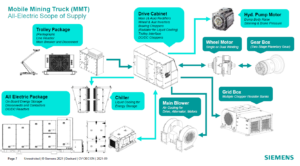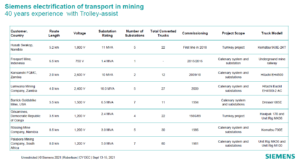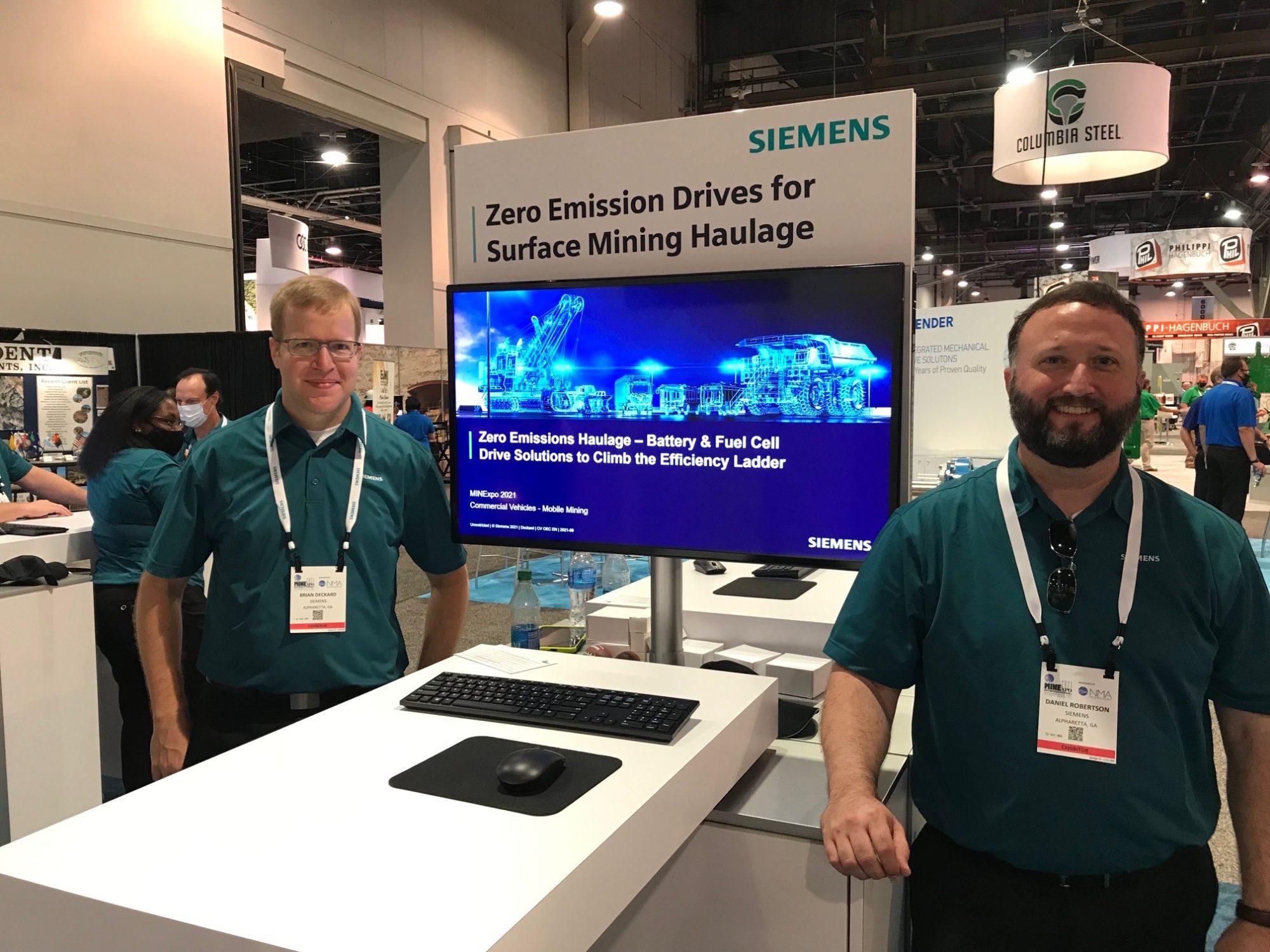There is no doubt that the all-electric mining truck using onboard energy storage with charging from an offboard trolley line is a principal solution for zero-emissions that a lot of the industry is looking at. IM Editorial Director, Paul Moore had the chance at MINExpo 2021 recently to meet with Daniel Robertson (right in picture), Siemens Business Development Manager and Brian Deckard (left in picture), Siemens Haul Truck Product Manager, to discuss Siemens’ take on the electrification roadmap and transition in mining.

Siemens has continued to innovate in the trolley space by designing relocatable infrastructure in the form of trolley poles attached by flange to movable ballast bases on concrete pads
Siemens is unquestionably one of the best positioned companies when looking from a depth and breadth of experience point of view – the company had already performed significant testing and research when its then VP of Mobile Mining, Norbert Becker, outlined its proposals at IM’s The Electric Mine conference in Toronto back in April 2019. In fact, Siemens was recently shortlisted as one of the 21 technology suppliers in the Charge On Innovation Challenge, an industry wide challenge addressing the need for efficient charging of battery electric haul trucks.

According to a recent McKinsey report, mining is responsible for 2-3% of global CO2 emissions. Therefore, miners are facing pressures from regulators, investors, and customers to decarbonise. Many mining stakeholders have goals to reduce their carbon emissions by 50% by 2030, and to be carbon neutral by 2050. Within mining, some 40-50% of CO2 emissions come from diesel engines for mobile mining equipment – the major share of so-called Scope 1 emissions. Siemens addresses this challenge by leveraging its experience and innovation in electrification of mining equipment.
Robertson told IM: “Siemens has provided electric drive systems for mining equipment for over 45 years, trolley assist for over 40 years and ultra class haul trucks for 25 years. Our approach has consistently been to provide the power conversion, not the energy source. We have maintained that approach with our Zero-Emission drive systems. In doing so, we remain energy agnostic. In other words, we are able to partner with energy storage suppliers or fuel cell suppliers just as effectively as we have partnered with diesel engine suppliers.”
While there are multiple zero-emission solutions emerging, Siemens’ Zero-Emission solution is already fully patented (Patent US 10,286,787 B2, filed September 27, 2013, granted May 14, 2019). This solution combines on-board energy storage with an off-board power supply through its proven trolley assist offering. For on-board energy storage, Deckard states that Siemens has thus far focused on Lithium Titanate Oxide (LTO) batteries and lithium supercapacitors due to their high inherent safety, 6C or greater charge/discharge power and long cycle life – capable of powering an all-electric truck throughout its design life without replacement.
Technology wise, Siemens mining truck development history has included a phased evolution including the GTO inverter truck from the mid-1990s, its IGBT inverter truck in the early-2000s, its Peak Shaving UltraCap drive in the early-2010s, a hybrid LTO battery truck in the late-2010s and now its all-electric LTO battery truck in the early-2020s. Overall, across mining and other industries, Siemens has delivered more than 900 off-highway and 16,000 on-highway electric vehicles with a variety of hybrid, battery, and fuel cell configurations.

In addition to its traditional diesel/electric offering, Siemens offers multiple options giving mining customers flexibility to reduce and/or eliminate carbon emissions – 1) trolley assist with diesel/electric, 2) hybrid on-board energy storage with diesel/electric, 3) fuel cell with on-board energy storage, and 4) trolley assist with on-board energy storage. The latter offers the highest productivity (highest speed on grade) as well as the highest overall energy efficiency from production to consumption (capture of regen and efficient delivery of trolley power to batteries and direct to wheels).
Siemens hands down has the most experience with trolley assist systems in mining, dating from the 1980s to the present, with several new projects in the offing. Siemens has also continued to innovate in the trolley space by designing relocatable infrastructure in the form of trolley poles attached by flange to movable ballast bases on concrete pads. These types of innovations are going to prove important as more and more miners look to trolley with or without on-board battery.
Siemens is also the only supplier to provide the off-board trolley infrastructure, as well as the on-board electrical drive system and energy storage system. Robertson adds: “By strategically locating the off-board trolley system on grade, we provide power directly to the wheels when it is needed most, thereby minimising the required on-board energy storage and maximising the payload capability. Power from the trolley system enables in-cycle charging and simultaneously unleashes the full power/torque capability of the traction motors, which is otherwise limited by the diesel engine or other similarly sized energy sources. This enables the all-electric haul truck, powered by trolley, to propel on-grade up to twice as fast as other solutions.”











